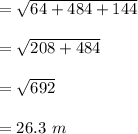
You are standing on a street corner with your friend. You then travel 14.0 m due west across the street and into your apartment building. You travel in the elevator 22.0 m upward to your floor, walk 12.0 m north to the door of your apartment, and then walk 6.0 m due east to your balcony that overlooks the street. Your friend is standing where you left her. how far are you from your friend?

Answers: 2


Another question on Physics

Physics, 21.06.2019 18:50
Study the following reaction carefully. what classification should this reaction have? 4al + 3o2 2al2o3synthesisdecompositionsingle replacementdouble displacement
Answers: 1

Physics, 21.06.2019 22:30
Follow these directions and answer the questions. 1. shine a pencil-thin beam of light on a mirror perpendicular to its surface. (if you don't have a laser light as suggested in the video, you can make a narrow beam from a flashlight by making a cone from black construction paper and taping it over the face of the flashlight.) how does the light reflect? how does the relationship of incident to reflected ray relate to the reflection of water waves moving perpendicular to a barrier? 2. shine a pencil-thin beam of light on a mirror standing on a sheet of paper on the table (or floor) so that you can mark the incident ray and reflected ray. (you can support the mirror from the back by taping it to a wooden block.) 3. mark a line on the paper representing the reflective surface. (the reflective surface of a mirror is usually the back edge.) 4. draw a dashed line perpendicular to the mirror surface at a point where the incident and reflected ray meet. this perpendicular is called a normal to the surface. 5. measure the angles between the rays and the normal. the angle of incidence is the angle formed by the incident ray and the normal to the surface. the angle formed by the reflected ray and normal is called the angle of reflection (r). what is the angle of incidence? what is the angle of reflection? 6. repeat for several different angles. (see report sheet for details.) what appears to be the relationship between the angle of incidence and angle of reflection? in science 1204, what was the relationship for these two angles made by the reflection of waves in a ripple tank? 7. roll a ball bearing so that it hits a fixed, hard surface (a metal plate) at several angles (including head-on). observe the way in which the ball bearing reflects. what generalization can you make about how a ball bearing reflects from a wall? have you proved that light can only behave like a wave?
Answers: 1

Physics, 21.06.2019 23:00
The key to stability is feedback between the reservoir and the fluxes into and/or out of the reservoir. assume that the rate of outflow from a reservoir depends on the size of the reservoir according to the following relationship: outflow rate= k x (size of reservoir), where k is a constant. a reservoir of water has a volume of 5000 liters, and the rate of outflow at steady state is 25 liters per minute. what is k? (give both the numerical value and its units.) what is the residence time? what is the relationship between k and the residence time?
Answers: 1

Physics, 22.06.2019 05:00
The earth is constantly spinning on its axis, like you might spin a basketball on your finger. it is this spinning of the earth that causes
Answers: 3
You know the right answer?
You are standing on a street corner with your friend. You then travel 14.0 m due west across the str...
Questions

Business, 24.10.2021 22:20




Mathematics, 24.10.2021 22:20

English, 24.10.2021 22:20


History, 24.10.2021 22:20

Mathematics, 24.10.2021 22:20

Physics, 24.10.2021 22:20

Mathematics, 24.10.2021 22:20

Mathematics, 24.10.2021 22:20


English, 24.10.2021 22:20

Mathematics, 24.10.2021 22:20

Chemistry, 24.10.2021 22:20


Social Studies, 24.10.2021 22:20

Social Studies, 24.10.2021 22:20

Mathematics, 24.10.2021 22:20



 :
:





